United States Astronaut Hall of Fame: Difference between revisions
→History: typo correction |
→History: rmv deprecated, ambiguous "current" per MOS:RELTIME Tags: Mobile edit Mobile app edit Android app edit |
||
| (336 intermediate revisions by more than 100 users not shown) | |||
| Line 1: | Line 1: | ||
{{Short description|Facility at Kennedy Space Center honoring American astronauts}} |
|||
The U.S. Astronaut Hall of Fame is located in [[Titusville, Florida]]. It features a large collection of personal astronaut memorabilia, particularly focusing on those astronauts who have been inducted into the Hall of Fame. |
|||
[[File:Statue of Alan Shepard.jpg|thumb|Statue of [[Alan Shepard]], the first American in space and the fifth person to walk on the Moon, located at the entrance]] |
|||
The '''United States Astronaut Hall of Fame''', located inside the [[Kennedy Space Center Visitor Complex]] Heroes & Legends building on [[Merritt Island, Florida]], honors American [[astronaut]]s and features the world's largest collection of their personal memorabilia, focusing on those astronauts who have been inducted into the Hall. Exhibits include [[Wally Schirra]]'s ''[[Mercury-Atlas 8|Sigma 7]]'' space capsule from the fifth crewed [[Project Mercury|Mercury]] mission and the [[Gemini IX]] [[spacecraft]] flown by [[Gene Cernan]] and [[Thomas P. Stafford]] in 1966. |
|||
==History== |
==History== |
||
[[Image:Project Mercury-Mercury Seven-Astronauts.jpg|left|thumb|The [[Mercury astronauts]] in 1962, inducted 1990]] |
|||
The idea behind the museum originated in the 1980s, when the then-six surviving [[Mercury Seven]] astronauts began working towards establishing a place where space travelers could be remembered and honored, along the lines of Halls of Fame for other fields.[http://www.astronautscholarship.org/ahof.html] |
|||
In the 1980s, the six then-surviving [[Mercury Seven]] astronauts conceived of establishing a place where US space travelers could be remembered and honored, along the lines of [[Hall of fame|halls of fame]] for other fields.<ref>[http://www.astronautscholarship.org/ahof.html U.S. Astronaut Hall of Fame at Kennedy Space Center Visitor Complex] {{webarchive|url=https://web.archive.org/web/20090519102131/http://astronautscholarship.org/ahof.html |date=2009-05-19 }}, retrieved 2007-08-23</ref> The Mercury Seven Foundation and Astronaut Scholarship Foundation were formed, and have a role in the ongoing operations of the Hall of Fame. The foundation's first executive director was former [[Associated Press]] space reporter Howard Benedict. <!-- not [[Howard Benedict]] --> |
|||
[[Image:U.S. Astronaut Hall of Fame (KSC-2014-1768).jpg|thumb|Entrance to the original Astronaut Hall of Fame]] |
|||
The museum opened in 1990. The museum eventually closed but was reopened on December 14, 2002. <ref> http://www.worldspaceflight.com/bios/hall_of_fame.htm </ref> It was originally privately operated but changed managements to the the privately run, [[Kennedy Space Center]] Visitor Complex, which privately operated by a contract from [[NASA]], and receives input from the Astronaut Scholarship Foundation, which supervises the selection of astronauts for induction into the Hall. |
|||
The Astronaut Hall of Fame was opened on October 29, 1990, by the U.S. Space Camp Foundation, which was the first owner of the facility. It was located next to the Florida branch of [[United States Space Camp|Space Camp]].<ref>{{cite news | url=http://archives.seattletimes.nwsource.com/cgi-bin/texis.cgi/web/vortex/display?slug=1101377&date=19901030&query=Astronaut+hall+of+fame | title=Mercury Museum -- Hall Of Fame Honors 7 Who Blazed A Trail In Space | author=Jay Clarke | publisher=The Seattle Times | date=1990-10-30 | access-date=2007-05-27}}</ref> |
|||
The Hall of Fame closed for several months in 2002 when U.S. Space Camp Foundation's creditors foreclosed on the property due to low attendance and mounting debt.<ref>{{cite news | url=http://www.space.com/news/fl_spacecamp_020806.html | title=Space Camp Florida Faces Foreclosure, Low Attendance Partly to Blame | publisher=Florida Today | author=Corey Schubert | date=2002-08-07 | access-date=2007-05-27 | archive-url=https://web.archive.org/web/20080618174410/http://www.space.com/news/fl_spacecamp_020806.html | archive-date=2008-06-18 | url-status=dead }}</ref> That September, an auction was held and the property was purchased by [[Delaware North Companies|Delaware North Park Services]] on behalf of [[NASA]] and the property was added to the Kennedy Space Center Visitor Complex. The Hall of Fame re-opened December 14, 2002.<ref>{{cite web| url=http://www.spaceref.com/news/viewpr.html?pid=10153 | title=Astronaut Hall of Fame Reopens to Public Saturday, Dec. 14 As Newest Attraction at Kennedy Space Center Visitor Complex | publisher=Kennedy Space Center Visitor Complex | date=2002-12-14 | access-date=2007-05-27}}</ref> |
|||
==Controversy== |
|||
The space suit of astronaut [[Gus Grissom]] is on display. When the museum changed ownership, members of Grissom's family objected to the display of the spacesuit and requested that it be returned to them. They believe that Grissom's death was not an accident and object to a NASA-contracted organization making money from a museum which displays the spacesuit. NASA maintains that the spacesuit is their property.<ref>RoadsideAmerica.com, [http://www.roadsideamerica.com/tnews/NewsItemDisplay.php?Tip_AttrId==7014 Luckless Gus Grissom in the hot seat again], [[November 24]][[2002]], retrieved [[May 4]][[2007]]</ref> |
|||
The Hall of Fame, which was originally located just west of the NASA Causeway, closed to the public on November 2, 2015, in preparation for its relocation to the Kennedy Space Center Visitor Complex 6 miles (9.7 km) to the east on Merritt Island. Outside of the original building was a full-scale replica of a Space Shuttle orbiter named ''[[Space Shuttle Inspiration|Inspiration]]'' (originally named "Shuttle To Tomorrow" where visitors could enter and view a program). ''Inspiration'' served only as an outdoor, full scale, static display which visitors could not enter. After the Hall of Fame was transferred to the KSC Visitor Complex, ''Inspiration'' was acquired by LVX System and was placed in storage at the Shuttle Landing Facility at the Kennedy Space Center; in 2016, the shuttle was loaded on to a barge to be taken for refurbishment before going on an educational tour.<ref>{{cite web |last1=Dean |first1=James |title=Shuttle model 'Inspiration' barging into new mission |url=https://www.floridatoday.com/story/tech/science/space/2016/01/15/shuttle-model-inspiration-barging-into-new-mission/78751148/ |website=[[Florida Today]] |access-date=January 26, 2021 |location=Viera, FL |date=January 15, 2016}}</ref> |
|||
The building was purchased at auction by visitor complex operator [[Delaware North]] and renamed the ATX Center, and for a time housed educational programs including Camp Kennedy Space Center and the Astronaut Training Experience.<ref>{{Cite news|url=https://www.floridatoday.com/story/tech/science/space/2015/10/26/us-astronaut-hall-fame-closing-soon-relocation/74337790/|title=U.S. Astronaut Hall of Fame closing soon for relocation|work=Florida Today|access-date=2018-07-28|language=en}}</ref> Those programs have since been moved to the KSC Visitor Complex, and as of December 2019, the structure was being offered for lease. In July 2020, Lockheed Martin announced it would lease the building to support work on the NASA [[Orion (spacecraft)|Orion]] crew capsule.<ref>{{cite news | url=https://www.floridatoday.com/story/tech/science/space/2020/07/17/lockheed-martin-lease-former-ksc-building-nasa-orion-spacecraft-titusville/5435874002/ | title=Lockheed Martin will lease former Astronaut Hall of Fame for NASA's Orion spacecraft | publisher=Florida Today | author=Emre Kelly | date=2020-07-17 | access-date=2020-09-15}}</ref> |
|||
==Inductees== |
==Inductees== |
||
{{See also|Category:United States Astronaut Hall of Fame inductees}} |
|||
Inductees into the Hall of Fame are selected by a blue ribbon committee of former NASA officials and flight controllers, historians, journalists, and other space authorities (including former astronauts) based on their accomplishments in space or their contributions to the advancement of space exploration.<ref>{{cite web|url=http://www.boeing.com/ids/news/2004/q2/nr_040504m.html |title=Boeing Executive Inducted Into Astronaut Hall of Fame |publisher=The Boeing Company |date=2004-05-04 |access-date=2007-05-27 |url-status=dead |archive-url=https://web.archive.org/web/20080613180721/http://www.boeing.com/ids/news/2004/q2/nr_040504m.html |archive-date=June 13, 2008 }}</ref> Except for 2002, inductions have been held every year since 2001. |
|||
Inductees include [[Neil Armstrong]], the first man to walk on the moon; [[John Glenn]], the first American to orbit the Earth; [[Alan Shepard]], the first American in space and one of twelve men to walk on the moon; [[Sally Ride]], the first American woman in space; and [[John Young (astronaut)|John Young]], a moonwalker and the commander of the first [[Space_Shuttle_program|space shuttle]] mission.<ref>[http://www.astronautscholarship.org/ahof_bios.html U.S. Astronaut Hall of Fame Inductee Biographies], retrieved [[May 4]][[2007]]</ref> |
|||
[[File:Neil Armstrong pose.jpg|left|upright=0.75|thumb|[[Neil Armstrong]], inducted 1993]] [[File:EdwardWhite.jpeg|right|upright=0.75|thumb|[[Ed White (astronaut)|Ed White]], inducted 1993]] |
|||
NASA [[Johnson Space Center]] director [[Michael Coats]] and astronomers [[Steven Hawley]] and [[Jeffrey A. Hoffman]] were inducted into the U.S. Astronaut Hall of Fame in May, 2007.<ref>[http://kennedyspacecenter.stores.yahoo.net/2007ahof.html 2007 U.S. Astronaut Hall of Fame Induction], retrieved [[May 4]][[2007]]</ref><ref>[http://www.hofmag.com/content/view/767/190/ U.S. Astronaut Hall of Fame to Add Three American Heroes in May], retrieved [[May 4]][[2007]]</ref><ref>Carreau, Mark, [http://www.chron.com/disp/story.mpl/front/4775725.html 3 NASA shuttle fliers to enter Astronaut Hall of Fame], The Houston Chronicle, [[May 4]][[2007]], retrieved [[May 4]][[2007]]</ref> Hawley and Hoffman are known for their efforts to launch and repair satellites, including the [[Hubble Space Telescope]]. |
|||
As its inaugural class in 1990, the Hall of Fame inducted the United States' original group of astronauts: the Mercury Seven. In addition to being the first American astronauts, they set several firsts in American spaceflight, both auspicious and tragic. [[Alan Shepard]] was the first American in space and later became one of the twelve people to walk on the Moon. [[John Glenn]] was the first American to orbit the [[Earth]] and after his induction went on, in 1998, to become the oldest man to fly in space, aged 77. [[Gus Grissom]] was the first American to fly in space twice and was the commander of the ill-fated [[Apollo 1]], which resulted in the first astronaut deaths directly related to preparation for spaceflight.<ref>{{cite news|url=https://www.newspapers.com/clip/33222502/victoria_advocate/|title=Mercury Astronauts Dedicate Hall of Fame at Florida Site|newspaper=Victoria Advocate|location=Victoria, Texas|date=May 12, 1990|page=38|via=Newspapers.com|agency=Associated Press}}</ref> |
|||
[[File:Sally Ride (1984).jpg|left|upright=0.75|thumb|[[Sally Ride]], inducted 2003]][[File:Guion Bluford.jpg|right|upright=0.75|thumb|[[Guion Bluford|Guy Bluford]], inducted 2010]] |
|||
Thirteen astronauts from the [[Project Gemini|Gemini]] and [[Apollo program|Apollo]] programs were inducted in the second class of 1993.<ref>{{cite news|url=https://www.newspapers.com/clip/33582881/florida_today/|title=Activities Honor Gemini Astronauts|newspaper=Florida Today|location=Cocoa, Florida|date=March 14, 1993|page=41|via=Newspapers.com|last1=Clark|first1=Amy}}</ref> This class included the first and last humans to walk on the Moon, [[Neil Armstrong]] and [[Eugene Cernan]]; [[Ed White (astronaut)|Ed White]], the first American to [[Extra-vehicular activity|walk in space]] (also killed in the Apollo 1 accident); [[Jim Lovell]], commander of the famously near-tragic [[Apollo 13]]; and [[John Young (astronaut)|John Young]], whose six flights included a moonwalk and command of the first [[Space Shuttle program|Space Shuttle]] mission. |
|||
The third class was inducted in 1997 and consisted of the 24 additional Apollo, [[Skylab]], and ASTP astronauts. Notable members of the class were [[Roger Chaffee]], the third astronaut killed in the Apollo 1 fire and the only unflown astronaut in the Hall; [[Harrison Schmitt]], the first scientist and next-to-last person to walk on the [[Moon]]; and [[Jack Swigert]] and [[Fred Haise]], the Apollo 13 crewmembers not previously inducted. |
|||
The philosophy regarding the first three groups of inductees was that all astronauts who flew in NASA's "pioneering" programs (which would include Mercury, Gemini, Apollo, Apollo Applications Program (Skylab), and Apollo-Soyuz Test Project) would be included simply by virtue of their participation in a spaceflight in these early programs. The first group (the inaugural class of 1990) would only include the original Mercury astronauts (most of whom would go on to fly in later programs). The second group of inductees would include those astronauts who began their spaceflight careers during Gemini (all of whom would go on to fly in later programs). The third group of inductees would include those astronauts who began their spaceflight careers during Apollo, Skylab, and ASTP (some of whom would go on to fly in the Space Shuttle program). Since it would not be practical (or meaningful) to induct all astronauts who ever flew in space, all subsequent inductees (Space Shuttle program and beyond) are considered based on their accomplishments and contributions to the human spaceflight endeavor which would set them apart from their peers. |
|||
Over four dozen astronauts from the Space Shuttle program have been inducted since 2001. Among these are [[Sally Ride]], the first American woman in space; [[Story Musgrave]], who flew six missions in the 1980s and 90s; and [[Francis Scobee]], commander of the [[Space Shuttle Challenger Disaster|ill-fated final ''Challenger'' mission]].<ref name="list">[http://www.astronautscholarship.org/ahof.html U.S. Astronaut Hall of Fame at KSC Visitor Complex - Astronaut Scholarship Foundation] {{webarchive|url=https://web.archive.org/web/20090519102131/http://astronautscholarship.org/ahof.html |date=2009-05-19 }}, United States Astronaut Hall of Fame, retrieved 2009-05-04</ref> |
|||
The 2010 class consisted of [[Guion Bluford|Guion Bluford Jr.]], [[Kenneth Bowersox]], [[Frank Culbertson]] and [[Kathryn Thornton]].<ref>{{cite web |url=http://www.astronautscholarship.org/2010ahof_induction.html |title=2010 U.S. Astronaut Hall of Fame Induction Gala |publisher=Astronaut Scholarship Foundation |access-date=May 10, 2010 |url-status=dead |archive-url=https://web.archive.org/web/20100501074629/http://astronautscholarship.org/2010ahof_induction.html |archive-date=May 1, 2010 }}</ref> The 2011 inductees were [[Karol Bobko]] and [[Susan Helms]].<ref>{{cite web|url=http://astronautscholarship.org/2011ahof_induction.html|title=2011 U.S. Astronaut Hall of Fame Induction|website=Astronautscholarship.org|access-date=10 August 2017|archive-url=https://web.archive.org/web/20110217174551/http://astronautscholarship.org/2011ahof_induction.html|archive-date=17 February 2011|url-status=dead|df=dmy-all}}</ref> The 2012 inductees were [[Franklin Chang-Diaz]], [[Kevin Chilton]] and [[Charles Precourt]].<ref>{{cite web|url=http://www.collectspace.com/news/news-050612a.html|title=Astronaut Hall of Fame's new space shuttle inductees humbled by heroes' welcome - collectSPACE|website=collectSPACE.com|access-date=10 August 2017}}</ref> [[Bonnie Dunbar]], [[Curt Brown]] and [[Eileen Collins]] were inducted in 2013,<ref>"Astronaut Hall of Fame adds space shuttle vets Brown, Collins and Dunbar" April 21, 2013 ''CollectSpace.com''</ref> and [[Shannon Lucid]] and [[Jerry L. Ross|Jerry Ross]] comprised the 2014 class.<ref>"Astronaut Hall of Fame inducts two record-setting space shuttle fliers" May 4, 2013 ''CollectSpace.com''</ref> |
|||
Those inducted in 2015 were [[John Grunsfeld]], [[Steven Lindsey]], [[Kent Rominger]], and [[Rhea Seddon]]. In 2016, inductees included [[Brian Duffy (astronaut)|Brian Duffy]] and [[Scott E. Parazynski]]. [[Ellen Ochoa]] and [[Michael Foale]] were announced as the 2017 class of the United States Astronaut Hall of Fame. [[Scott Altman]] and [[Thomas David Jones|Thomas Jones]] followed in 2018. The 2019 inductees were [[James Buchli]] and [[Janet L. Kavandi]].<ref name="halloffame">{{cite web|url=http://astronautscholarship.org/programs-and-events/ahof-induction/ | title=U.S. Astronaut Hall of Fame Induction Ceremony & Gala |access-date=February 22, 2017 }}</ref> |
|||
[[Michael López-Alegría]], [[Scott Kelly (astronaut)|Scott Kelly]] and [[Pamela Melroy]] were the 2020 inductees, inducted in a November 2021 ceremony. The 2022 inductees were [[Christopher Ferguson]], [[David Leestma]], and [[Sandra Magnus]]. [[Roy D. Bridges Jr.|Roy Bridges Jr.]] and [[Mark Kelly]] were the 2023 inductees.<ref>[https://www.nasa.gov/feature/two-space-pioneers-inducted-into-astronaut-hall-of-fame NASA article on the 2023 inductees]</ref> |
|||
{{clear}} |
|||
==Exhibits== |
==Exhibits== |
||
[[Image:Mercury-Redstone 4 Spacesuit.jpg|thumb|upright=0.75|left|[[Gus Grissom]]'s [[Mercury-Redstone 4|Mercury]] spacesuit]] |
|||
The [[Mercury-Atlas 8|Sigma 7]] [[Project Mercury|Mercury spacecraft]] and the [[Apollo 14]] [[Apollo Command/Service Module|Command Module]] are on display as well as Gus Grissom's space suit. There is also an Astronaut Adventure room which acts as a simulator for use by children. |
|||
[[Image:Sigma7-2.jpg|thumb|right| [[Mercury-Atlas 8|''Sigma 7'']] Mercury spacecraft, flown by [[Wally Schirra]] in 1962]] |
|||
[[File:Gemini9a.jpg|thumb|[[Gemini 9A]] capsule, flown by [[Thomas P. Stafford]] and [[Eugene Cernan]] in 1966]] |
|||
The Hall of Heroes is composed of tributes to the inductees. Among the Hall of Fame's displays is ''[[Mercury-Atlas 8|Sigma 7]]'', the Mercury spacecraft piloted by Wally Schirra which orbited the Earth six times in 1962, and the [[Gemini 9A]] capsule flown by [[Gene Cernan]] and [[Thomas P. Stafford]] in 1966. An Astronaut Adventure room includes simulators for use by children. |
|||
The [[spacesuit]] worn by Gus Grissom during his 1961 [[Mercury-Redstone 4|''Liberty Bell 7'' Mercury flight]] is on display and has been the subject of a dispute between NASA and Grissom's heirs and supporters since 2002. The spacesuit, along with other Grissom artifacts, were loaned to the original owners of the Hall of Fame by the Grissom family when it opened. After the Hall of Fame went into bankruptcy and was taken over by a NASA contractor in 2002, the family requested that all their items be returned.<ref>{{cite news | url=http://www.space.com/news/grissom_spacesuit_021120.html | title=Gus Grissom's Family, NASA Fight Over Spacesuit | publisher=Florida Today | author=John Kelly | date=2002-11-20 | access-date=2007-05-27}}</ref> All of the items were returned to Grissom's family except the spacesuit, because both NASA and the Grissoms claim ownership of it.<ref>{{cite news|url = https://www.washingtonpost.com/archive/politics/2002/11/30/nasa-astronauts-family-fight-over-a-spacesuit/5f0fde2b-3514-4399-8d2a-a7275ddc35ac/|title = NASA, Astronaut's Family Fight Over a Spacesuit|date = 2002-11-30|newspaper = [[The Washington Post]]|access-date = 2007-05-04}}</ref> NASA claims Grissom checked out the spacesuit for a [[show and tell (education)|show and tell]] at his son's school, and then never returned it, while the Grissoms claim Gus rescued the spacesuit from a scrap heap.<ref>{{cite news | url=https://www.washingtonpost.com/wp-dyn/content/article/2005/08/23/AR2005082301204_pf.html | title=Grissom Spacesuit in Tug of War | newspaper=Washington Post | author=Christopher Lee | date=2005-08-24 | access-date=2007-05-27}}</ref> |
|||
| ⚫ | |||
| ⚫ | |||
==Gallery== |
|||
| ⚫ | |||
<gallery widths="250px" perrow="3"> |
|||
| ⚫ | |||
File:Alan Shepard Apollo spacesuit.jpg|[[Alan Shepard]]'s [[Apollo 14]] lunar space suit |
|||
*Worldspaceflight.com list of inductees and dates of induction [http://www.worldspaceflight.com/bios/hall_of_fame.htm] |
|||
File:Genesis rock.jpg|Replica of [[Apollo 15]] [[Genesis Rock]] |
|||
File:Space flight flag.jpg|Flag flown on the first crewed US spaceflight (''[[Mercury-Redstone 3|Freedom 7]]'' in 1961) and the 100th ([[STS-71]] in 1995) |
|||
File:Gemini Space Suit.jpg|A [[Gemini 7]] [[Gemini space suit#G5C suits|G5C spacesuit]] |
|||
File:SpaceShuttleReplicaInspiration.JPG|Full-scale replica of a Space Shuttle orbiter which once stood adjacent to the United States Astronaut Hall of Fame |
|||
</gallery> |
|||
==See also== |
|||
[[File:2016 PANO Meteor Crater 02.jpg|thumb|The American Astronaut Wall of Fame at the [[Meteor Crater]] site near Winslow, Arizona.]] |
|||
*[[Kennedy Space Center Visitor Complex]] |
|||
*[[List of astronauts by year of selection]] for training |
|||
*[[Space Mirror Memorial]] |
|||
*[[American Space Museum|US Space Walk of Fame]] |
|||
*[[New Mexico Museum of Space History#International Space Hall of Fame|International Space Hall of Fame]] |
|||
*[[List of aerospace museums]] |
|||
* [[North American aviation halls of fame]] |
|||
==References== |
==References== |
||
{{ |
{{Reflist}} |
||
| ⚫ | |||
{{Commons category|Astronaut Hall of Fame}} |
|||
| ⚫ | |||
*[https://www.kennedyspacecenter.com/explore-attractions/heroes-and-legends/us-astronaut-hall-of-fame Another Kennedy Space Center HOF link] |
|||
*[https://www.astronautscholarship.org/ahof.html November, 2021, induction ceremony] |
|||
| ⚫ | |||
| ⚫ | |||
*[https://web.archive.org/web/20070807230200/http://www.worldspaceflight.com/bios/hall_of_fame.htm Worldspaceflight.com list of inductees and dates of induction] |
|||
{{U.S. Astronaut Hall of Fame}} |
|||
{{NASA space program|state=collapsed}} |
|||
{{coord|28.522840|-80.683022|type:landmark_region:US-FL|display=title}} |
|||
{{authority control}} |
|||
{{space-stub}} |
|||
[[Category: |
[[Category:United States Astronaut Hall of Fame inductees|*]] |
||
[[Category:Aviation halls of fame]] |
|||
[[Category:U.S._Astronaut_Hall_of_Fame_Inductees|*Astronaut Hall of Fame]] <!-- * separates it from the actual inductees in the list --> |
|||
[[Category:Halls of fame in Florida|Astro]] |
|||
[[Category:Aerospace museums in Florida]] |
|||
[[Category:Space Shuttle tourist attractions]] |
|||
[[Category:Museums in Brevard County, Florida]] |
|||
[[Category:Buildings and structures in Titusville, Florida]] |
|||
[[Category:Awards established in 1990]] |
|||
[[Category:1990 establishments in Florida]] |
|||
[[Category:Museums established in 1990]] |
|||
[[Category:History of spaceflight]] |
|||
Revision as of 14:32, 26 August 2023
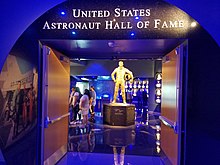
The United States Astronaut Hall of Fame, located inside the Kennedy Space Center Visitor Complex Heroes & Legends building on Merritt Island, Florida, honors American astronauts and features the world's largest collection of their personal memorabilia, focusing on those astronauts who have been inducted into the Hall. Exhibits include Wally Schirra's Sigma 7 space capsule from the fifth crewed Mercury mission and the Gemini IX spacecraft flown by Gene Cernan and Thomas P. Stafford in 1966.
History

In the 1980s, the six then-surviving Mercury Seven astronauts conceived of establishing a place where US space travelers could be remembered and honored, along the lines of halls of fame for other fields.[1] The Mercury Seven Foundation and Astronaut Scholarship Foundation were formed, and have a role in the ongoing operations of the Hall of Fame. The foundation's first executive director was former Associated Press space reporter Howard Benedict.
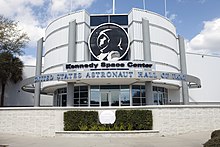
The Astronaut Hall of Fame was opened on October 29, 1990, by the U.S. Space Camp Foundation, which was the first owner of the facility. It was located next to the Florida branch of Space Camp.[2]
The Hall of Fame closed for several months in 2002 when U.S. Space Camp Foundation's creditors foreclosed on the property due to low attendance and mounting debt.[3] That September, an auction was held and the property was purchased by Delaware North Park Services on behalf of NASA and the property was added to the Kennedy Space Center Visitor Complex. The Hall of Fame re-opened December 14, 2002.[4]
The Hall of Fame, which was originally located just west of the NASA Causeway, closed to the public on November 2, 2015, in preparation for its relocation to the Kennedy Space Center Visitor Complex 6 miles (9.7 km) to the east on Merritt Island. Outside of the original building was a full-scale replica of a Space Shuttle orbiter named Inspiration (originally named "Shuttle To Tomorrow" where visitors could enter and view a program). Inspiration served only as an outdoor, full scale, static display which visitors could not enter. After the Hall of Fame was transferred to the KSC Visitor Complex, Inspiration was acquired by LVX System and was placed in storage at the Shuttle Landing Facility at the Kennedy Space Center; in 2016, the shuttle was loaded on to a barge to be taken for refurbishment before going on an educational tour.[5]
The building was purchased at auction by visitor complex operator Delaware North and renamed the ATX Center, and for a time housed educational programs including Camp Kennedy Space Center and the Astronaut Training Experience.[6] Those programs have since been moved to the KSC Visitor Complex, and as of December 2019, the structure was being offered for lease. In July 2020, Lockheed Martin announced it would lease the building to support work on the NASA Orion crew capsule.[7]
Inductees
Inductees into the Hall of Fame are selected by a blue ribbon committee of former NASA officials and flight controllers, historians, journalists, and other space authorities (including former astronauts) based on their accomplishments in space or their contributions to the advancement of space exploration.[8] Except for 2002, inductions have been held every year since 2001.
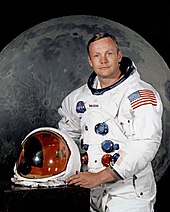
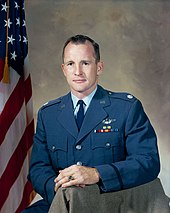
As its inaugural class in 1990, the Hall of Fame inducted the United States' original group of astronauts: the Mercury Seven. In addition to being the first American astronauts, they set several firsts in American spaceflight, both auspicious and tragic. Alan Shepard was the first American in space and later became one of the twelve people to walk on the Moon. John Glenn was the first American to orbit the Earth and after his induction went on, in 1998, to become the oldest man to fly in space, aged 77. Gus Grissom was the first American to fly in space twice and was the commander of the ill-fated Apollo 1, which resulted in the first astronaut deaths directly related to preparation for spaceflight.[9]
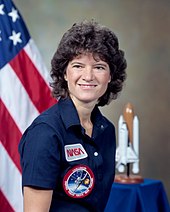
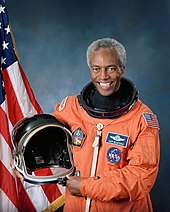
Thirteen astronauts from the Gemini and Apollo programs were inducted in the second class of 1993.[10] This class included the first and last humans to walk on the Moon, Neil Armstrong and Eugene Cernan; Ed White, the first American to walk in space (also killed in the Apollo 1 accident); Jim Lovell, commander of the famously near-tragic Apollo 13; and John Young, whose six flights included a moonwalk and command of the first Space Shuttle mission.
The third class was inducted in 1997 and consisted of the 24 additional Apollo, Skylab, and ASTP astronauts. Notable members of the class were Roger Chaffee, the third astronaut killed in the Apollo 1 fire and the only unflown astronaut in the Hall; Harrison Schmitt, the first scientist and next-to-last person to walk on the Moon; and Jack Swigert and Fred Haise, the Apollo 13 crewmembers not previously inducted.
The philosophy regarding the first three groups of inductees was that all astronauts who flew in NASA's "pioneering" programs (which would include Mercury, Gemini, Apollo, Apollo Applications Program (Skylab), and Apollo-Soyuz Test Project) would be included simply by virtue of their participation in a spaceflight in these early programs. The first group (the inaugural class of 1990) would only include the original Mercury astronauts (most of whom would go on to fly in later programs). The second group of inductees would include those astronauts who began their spaceflight careers during Gemini (all of whom would go on to fly in later programs). The third group of inductees would include those astronauts who began their spaceflight careers during Apollo, Skylab, and ASTP (some of whom would go on to fly in the Space Shuttle program). Since it would not be practical (or meaningful) to induct all astronauts who ever flew in space, all subsequent inductees (Space Shuttle program and beyond) are considered based on their accomplishments and contributions to the human spaceflight endeavor which would set them apart from their peers.
Over four dozen astronauts from the Space Shuttle program have been inducted since 2001. Among these are Sally Ride, the first American woman in space; Story Musgrave, who flew six missions in the 1980s and 90s; and Francis Scobee, commander of the ill-fated final Challenger mission.[11]
The 2010 class consisted of Guion Bluford Jr., Kenneth Bowersox, Frank Culbertson and Kathryn Thornton.[12] The 2011 inductees were Karol Bobko and Susan Helms.[13] The 2012 inductees were Franklin Chang-Diaz, Kevin Chilton and Charles Precourt.[14] Bonnie Dunbar, Curt Brown and Eileen Collins were inducted in 2013,[15] and Shannon Lucid and Jerry Ross comprised the 2014 class.[16]
Those inducted in 2015 were John Grunsfeld, Steven Lindsey, Kent Rominger, and Rhea Seddon. In 2016, inductees included Brian Duffy and Scott E. Parazynski. Ellen Ochoa and Michael Foale were announced as the 2017 class of the United States Astronaut Hall of Fame. Scott Altman and Thomas Jones followed in 2018. The 2019 inductees were James Buchli and Janet L. Kavandi.[17]
Michael López-Alegría, Scott Kelly and Pamela Melroy were the 2020 inductees, inducted in a November 2021 ceremony. The 2022 inductees were Christopher Ferguson, David Leestma, and Sandra Magnus. Roy Bridges Jr. and Mark Kelly were the 2023 inductees.[18]
Exhibits
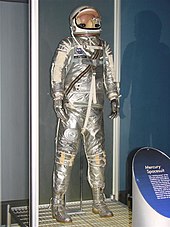
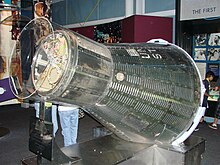
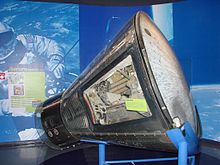
The Hall of Heroes is composed of tributes to the inductees. Among the Hall of Fame's displays is Sigma 7, the Mercury spacecraft piloted by Wally Schirra which orbited the Earth six times in 1962, and the Gemini 9A capsule flown by Gene Cernan and Thomas P. Stafford in 1966. An Astronaut Adventure room includes simulators for use by children.
The spacesuit worn by Gus Grissom during his 1961 Liberty Bell 7 Mercury flight is on display and has been the subject of a dispute between NASA and Grissom's heirs and supporters since 2002. The spacesuit, along with other Grissom artifacts, were loaned to the original owners of the Hall of Fame by the Grissom family when it opened. After the Hall of Fame went into bankruptcy and was taken over by a NASA contractor in 2002, the family requested that all their items be returned.[19] All of the items were returned to Grissom's family except the spacesuit, because both NASA and the Grissoms claim ownership of it.[20] NASA claims Grissom checked out the spacesuit for a show and tell at his son's school, and then never returned it, while the Grissoms claim Gus rescued the spacesuit from a scrap heap.[21]
Gallery
-
Alan Shepard's Apollo 14 lunar space suit
-
Replica of Apollo 15 Genesis Rock
-
Full-scale replica of a Space Shuttle orbiter which once stood adjacent to the United States Astronaut Hall of Fame
See also

- Kennedy Space Center Visitor Complex
- List of astronauts by year of selection for training
- Space Mirror Memorial
- US Space Walk of Fame
- International Space Hall of Fame
- List of aerospace museums
- North American aviation halls of fame
References
- ^ U.S. Astronaut Hall of Fame at Kennedy Space Center Visitor Complex Archived 2009-05-19 at the Wayback Machine, retrieved 2007-08-23
- ^ Jay Clarke (1990-10-30). "Mercury Museum -- Hall Of Fame Honors 7 Who Blazed A Trail In Space". The Seattle Times. Retrieved 2007-05-27.
- ^ Corey Schubert (2002-08-07). "Space Camp Florida Faces Foreclosure, Low Attendance Partly to Blame". Florida Today. Archived from the original on 2008-06-18. Retrieved 2007-05-27.
- ^ "Astronaut Hall of Fame Reopens to Public Saturday, Dec. 14 As Newest Attraction at Kennedy Space Center Visitor Complex". Kennedy Space Center Visitor Complex. 2002-12-14. Retrieved 2007-05-27.
- ^ Dean, James (January 15, 2016). "Shuttle model 'Inspiration' barging into new mission". Florida Today. Viera, FL. Retrieved January 26, 2021.
- ^ "U.S. Astronaut Hall of Fame closing soon for relocation". Florida Today. Retrieved 2018-07-28.
- ^ Emre Kelly (2020-07-17). "Lockheed Martin will lease former Astronaut Hall of Fame for NASA's Orion spacecraft". Florida Today. Retrieved 2020-09-15.
- ^ "Boeing Executive Inducted Into Astronaut Hall of Fame". The Boeing Company. 2004-05-04. Archived from the original on June 13, 2008. Retrieved 2007-05-27.
- ^ "Mercury Astronauts Dedicate Hall of Fame at Florida Site". Victoria Advocate. Victoria, Texas. Associated Press. May 12, 1990. p. 38 – via Newspapers.com.
- ^ Clark, Amy (March 14, 1993). "Activities Honor Gemini Astronauts". Florida Today. Cocoa, Florida. p. 41 – via Newspapers.com.
- ^ U.S. Astronaut Hall of Fame at KSC Visitor Complex - Astronaut Scholarship Foundation Archived 2009-05-19 at the Wayback Machine, United States Astronaut Hall of Fame, retrieved 2009-05-04
- ^ "2010 U.S. Astronaut Hall of Fame Induction Gala". Astronaut Scholarship Foundation. Archived from the original on May 1, 2010. Retrieved May 10, 2010.
- ^ "2011 U.S. Astronaut Hall of Fame Induction". Astronautscholarship.org. Archived from the original on 17 February 2011. Retrieved 10 August 2017.
- ^ "Astronaut Hall of Fame's new space shuttle inductees humbled by heroes' welcome - collectSPACE". collectSPACE.com. Retrieved 10 August 2017.
- ^ "Astronaut Hall of Fame adds space shuttle vets Brown, Collins and Dunbar" April 21, 2013 CollectSpace.com
- ^ "Astronaut Hall of Fame inducts two record-setting space shuttle fliers" May 4, 2013 CollectSpace.com
- ^ "U.S. Astronaut Hall of Fame Induction Ceremony & Gala". Retrieved February 22, 2017.
- ^ NASA article on the 2023 inductees
- ^ John Kelly (2002-11-20). "Gus Grissom's Family, NASA Fight Over Spacesuit". Florida Today. Retrieved 2007-05-27.
- ^ "NASA, Astronaut's Family Fight Over a Spacesuit". The Washington Post. 2002-11-30. Retrieved 2007-05-04.
- ^ Christopher Lee (2005-08-24). "Grissom Spacesuit in Tug of War". Washington Post. Retrieved 2007-05-27.
External links
- United States Astronaut Hall of Fame inductees
- Aviation halls of fame
- Halls of fame in Florida
- Aerospace museums in Florida
- Space Shuttle tourist attractions
- Museums in Brevard County, Florida
- Buildings and structures in Titusville, Florida
- Awards established in 1990
- 1990 establishments in Florida
- Museums established in 1990
- History of spaceflight





